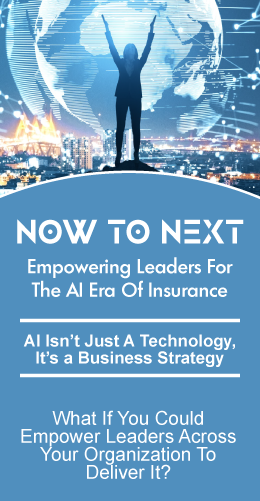
Artificial Intelligence (AI) is rapidly transforming industries worldwide, and the insurance sector is no exception. To stay competitive and advance your career, it’s crucial to develop a deeper understanding of AI and its impact on our industry.
This article will explore how you can anticipate AI-driven changes, contribute to your company’s AI strategies, and lead organizations as AI becomes more integrated into our workflows and customer interactions.
The AI Revolution in Insurance
AI technologies like ChatGPT, machine learning, and neural networks are revolutionizing how we conduct business. Historically, insurance relied on rule-based systems for decision-making. Today, AI’s capabilities allow for more dynamic and responsive processes. From streamlining claims processing to enhancing risk assessment, AI is rapidly changing the insurance landscape.
The evolution of AI began with simple, rule-based systems known as expert systems. These systems were designed to make decisions based on a set of predefined rules. While useful, they were limited in their ability to handle complex, real-world scenarios. The advent of machine learning (ML) marked a significant shift, enabling computers to learn from data and improve their performance over time without being explicitly programmed.
Deep learning (DL), a subset of ML, further advanced the field by utilizing neural networks with many layers to interpret complex patterns in data. This capability has led to the development of sophisticated AI applications, such as image recognition, natural language processing, and predictive analytics.
In the insurance sector, AI is used in various applications to enhance efficiency and accuracy. For instance, AI algorithms can analyze large datasets to identify patterns and predict future outcomes. This capability is particularly useful in underwriting, where AI can assess risk factors more accurately than traditional methods. Similarly, AI-driven chatbots and virtual assistants are improving customer service by providing instant responses to policyholder inquiries and automating routine tasks.
Anticipating AI-Driven Changes
As AI continues to evolve, customer expectations are shifting. Today’s customers expect personalized experiences, seamless interactions, and timely responses. AI’s applications in underwriting, claims processing, risk assessment, customer support, and fraud detection are setting new standards for efficiency and accuracy. Insurance professionals need to understand these changes to remain relevant and effective in their roles.
One of the most significant impacts of AI is its ability to provide personalized services. By analyzing customer data, AI can offer tailored insurance products and pricing. For example, usage-based insurance (UBI) models, which adjust premiums based on individual driving behavior, are becoming increasingly popular in auto insurance. Similarly, AI can predict customer needs and offer proactive risk management solutions, such as alerts for potential hazards or recommendations for preventive measures.
In claims processing, AI-powered systems can quickly assess damage from submitted photos, reducing the need for physical inspections and speeding up the settlement process. This not only improves efficiency but also enhances customer satisfaction by providing faster resolutions.
Staying informed about AI advancements is essential for insurance professionals. This involves continuous learning and keeping up-to-date with the latest developments in AI technology and its applications in the insurance industry. Engaging in industry conferences, online courses, and professional networks can help you stay ahead of the curve and anticipate the changes AI will bring.
Adding Your Voice to AI Strategies
Insurance professionals play a vital role in shaping their organization’s AI strategies. Engaging in AI discussions and contributing insights can drive more effective decision-making and operational efficiency. Practical steps include participating in AI-related training, collaborating with AI teams, and suggesting AI-driven improvements to existing processes. This proactive approach ensures that your voice helps guide AI priorities and strategies.
AI strategy development involves several key components: understanding the technology, identifying opportunities for AI integration, and aligning AI initiatives with business objectives. By actively participating in these discussions, you can help ensure that AI implementations are aligned with the needs and goals of your organization.
For example, you might identify areas where AI can streamline operations or improve customer interactions. In underwriting, AI can automate routine tasks, freeing up underwriters to focus on more complex cases. In claims processing, AI can quickly analyze data to detect fraud, reducing losses and improving efficiency.
Contributing to AI strategies also involves staying informed about ethical considerations and regulatory requirements. As AI becomes more integrated into business processes, it’s essential to address potential biases and ensure that AI systems are used responsibly. This includes developing guidelines for data privacy, transparency, and accountability.
Leading AI-Integrated Organizations
Visionary leadership is required to navigate the AI transition. Integrating AI into everyday workflows can enhance productivity and customer satisfaction. Ethical considerations are paramount; maintaining human oversight ensures that AI decisions are fair and transparent. Leaders must balance AI’s capabilities with human expertise to foster a productive and innovative work environment.
Leading an AI-integrated organization involves several key responsibilities. First, leaders must communicate the value of AI to their teams and stakeholders. This includes explaining how AI can enhance business operations and improve customer experiences. By fostering a culture of innovation and continuous learning, leaders can encourage their teams to embrace AI and explore its potential applications.
Second, leaders must ensure that AI implementations align with organizational goals and values. This involves setting clear objectives for AI initiatives, such as improving efficiency, reducing costs, or enhancing customer satisfaction. Leaders should also establish metrics to measure the success of AI projects and make data-driven decisions.
Third, leaders must address the ethical implications of AI. This includes ensuring that AI systems are used responsibly and transparently. For example, AI algorithms should be regularly audited for biases, and organizations should have policies in place to address any ethical concerns that arise. By maintaining human oversight, leaders can ensure that AI complements human decision-making rather than replacing it.
Building a Competitive Edge For Your Career and Company
Developing your AI literacy and evangelizing that knowledge across your organization is critical. Fostering a culture of continuous learning and innovation will empower your team to adapt to AI-driven changes. Collaborative efforts and upskilling are necessary to stay ahead. Proactively adopting AI not only enhances individual career prospects but also drives organizational success.
Building a competitive edge in the AI era involves several strategies. First, invest in your own AI education and then support efforts to provde training for your team. This includes offering courses, workshops, and hands-on experiences to help employees not only develop AI-related skills but also the insight they need to integrate AI strategically from a business standpoint. By building a knowledgeable workforce, you can better leverage AI technologies to achieve business goals.
Second, foster a culture of innovation and experimentation. Encourage your team to explore new AI applications and experiment with different approaches. This can lead to innovative solutions and improvements in business processes. Create an environment where employees feel comfortable taking risks and learning from failures.
Third, collaborate with external partners and experts. Partnering with AI startups, research institutions, and industry experts can provide valuable insights and access to cutting-edge technologies. By leveraging external expertise, you can accelerate AI adoption and stay ahead of competitors.
Fourth, focus on customer-centric AI applications. Use AI to enhance customer interactions and provide personalized services. For example, AI-driven chatbots can provide instant support to policyholders, while predictive analytics can offer tailored insurance products and pricing. By prioritizing customer needs, you can improve satisfaction and loyalty.
Conclusion
Understanding and leveraging AI in the insurance industry is no longer optional; it’s essential for staying competitive. By embracing AI-driven transformation, you can ensure that your career and organization thrive in the AI era. Start by staying informed, contributing to AI strategies, and leading with a focus on ethical AI integration. The future of insurance is AI-empowered, and the time to act is now.
To sum up, AI is transforming the insurance industry in unprecedented ways. By anticipating AI-driven changes, adding your voice to AI strategies, and leading AI-integrated organizations, you can build a competitive edge and advance your career. Embrace continuous learning, foster a culture of innovation, and collaborate with external partners to stay ahead in the AI era. The future of insurance is bright, and those who harness the power of AI will lead the way.
This article is written based on the insights found within our Now To Next AI Leadership Program for Insurance Professionals First Lesson, Demystifying Modern AIs And Their Impact. To gain a deeper understanding of these concepts and how Now To Next can help give you a leadership edge, please visit https://bit.ly/NTNDMdrnAI.
Executive Director, Now To Next







